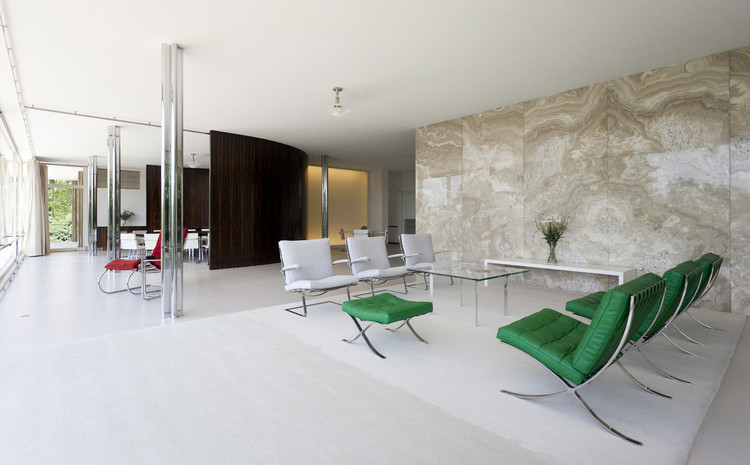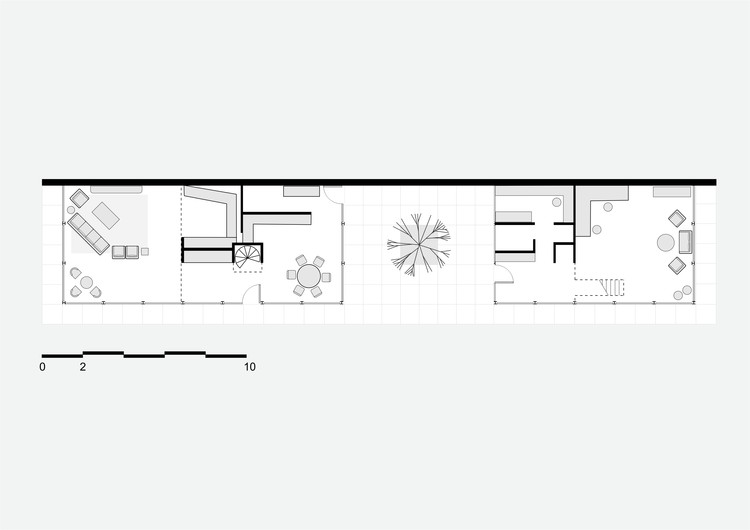
Le Corbusier's "Five Points of Architecture" functioned in the twentieth century as the go-to guide for architectural production; it is also a significant work in understanding the legacy of modern architecture. Horizontal windows, free design of the facade, pilotis, roof gardens, and perhaps the most significant point, free design of the ground plan form the Franco-Swiss architect's manifesto. In terms of design practice, this last point means distinguishing structure and wrapper, which allows the free disposal of dividing walls that no longer fulfill a structural function.
Residential projects were once characterized by a clear division of environments linked to domestic dynamics, now filtered by modern discourse, the house became flexible and capable of new spatial articulations.
To better understand the modern domestic space, we gathered some of the most emblematic examples of residences and their floor plans.
Villa Savoye

Considered the great manifesto for a new architecture, Le Corbusier's Villa Savoye was built between 1928 and 1929 in France. Together with Villa Stein (1926), both structures synthesized in a very rigorous way the implementation of the five points. As for the ground floor, Villa Savoye was structured from a modulation of pillars that are part of an independent structural system and proposes the residential unit as a living machine covered by the new technological advents of the time. The design of the horizontal plan responds to the diversity of demand for project uses and reveals the complexity of the relationships proposed by the architect.

In this case, it is worth highlighting the division of the programs vertically, since each floor tries to reinforce the ideas put forward in the architect's speech: the ground floor, designed from the perspective of the arrival of the car, receives programs linked to services; the intermediate floor contemplates the private and functional programs of the residence; while the upper floor receives the living space and the visual delight of the constructed work itself, all linked by the elements of circulation that promote the idea of the promenade.

Casa Curutchet

After an incessant search by Argentine professionals to carry out a residential project and medical office, its future owner, Pedro Domingo Curutchet, hired Le Corbusier to intervene in an area of La Plata. The site was never visited by the architect, which meant a great contribution on the part of another architect, Amancio Williams.
The result is a project that also directly expresses the premises of the free floor: its structure in reinforced concrete defined from the modulation of the pillars receives the programs in floors that are superimposed and articulated from elements of circulation around an inner courtyard and an access with pillars.

Farnsworth House

Farnsworth House was designed by Mies van der Rohe and built as a weekend home in Plano, Illinois between 1945 and 1951. Thought of as a ground floor pavilion that leaves the natural elements of the environment in direct contact with the interior of the house, delimited only by large glazed panels, the residence is an example of the free floor plan.

The structure consists of eight "I" profile steel pillars that support the slab and roof, while the glass panels delimit the project and are an irrevocable example of "less is more." In relation to the plan, its interior integrates all uses of domestic life, although some authors [1] consider this to be impersonal and imposed by the architect as a model for the everyday life of his client, Doctor Edith Farnsworth.
Villa Tugendhat

Another project by Mies van der Rohe, commissioned by a young couple who wanted the architect to propose a spacious house with simple forms, is directly aligned with the idea of the German-American architect's free plan. In this example, steel is also used as a structural element of the three-level volume that the program contemplates and is articulated based on variations in the slope of the terrain. In spite of being located in Brno, Czech Republic, the metal parts of the structure of the house were produced in Berlin, since at that time it was not common to resort to this type of material for residential constructions of the time.

Despite the effort, it was this metal structure that guaranteed a series of advantages explored by Mies in his projects, such as the possibility of lightening divisions and a free plan that could vary by level according to specific programs.
Eames House

Designed by architects Charles and Ray Eames as part of the Case Study Houses program, promoted by Arts and Architecture magazine, this 1945 house incorporates the new technologies that were available for civil construction developed during the Second World War. The two volumes articulated by the patio were designed from prefabricated elements.

In the case of this project, resorting to the free floor plan allowed the pavements of the volumes to set up relationships of double ceiling eight in some moments, creating diverse compositions and possibilities of spatial reading. In addition, the independent structure of steel profiles allows the free disposal of opaque and translucent colored panels, that contribute to generating interesting light effects in the interior of the house.
In this project, the free floor allowed for double-height spaces, creating different compositions and spatial possibilities. Also, the independent structure of steel profiles allowed for the free arrangement of opaque and translucent panels that generates interesting light effects in its interiors.
Rietveld Schröder House

The residence designed by Gerrit Rietveld in 1924 in the Netherlands is an example of total flexibilization of domestic spaces from a plan whose partitions can be altered. This is possible thanks to the use of retractable walls that can be gathered by articulating various environments of the house and eliminating the notion of hierarchy between the rooms and the daily activities of the family.

By providing a variety of design possibilities from the same orthogonal envelope, this project reiterates the virtues of thinking about the autonomy of structural elements in relation to the dynamics of internal environments.

References:
[1]: In her book Women and the Making of the Modern House: A Social and Architectural History, of 2006, Alice Friedman raises the question of how the relationship between architect and client is set up in modern projects.

